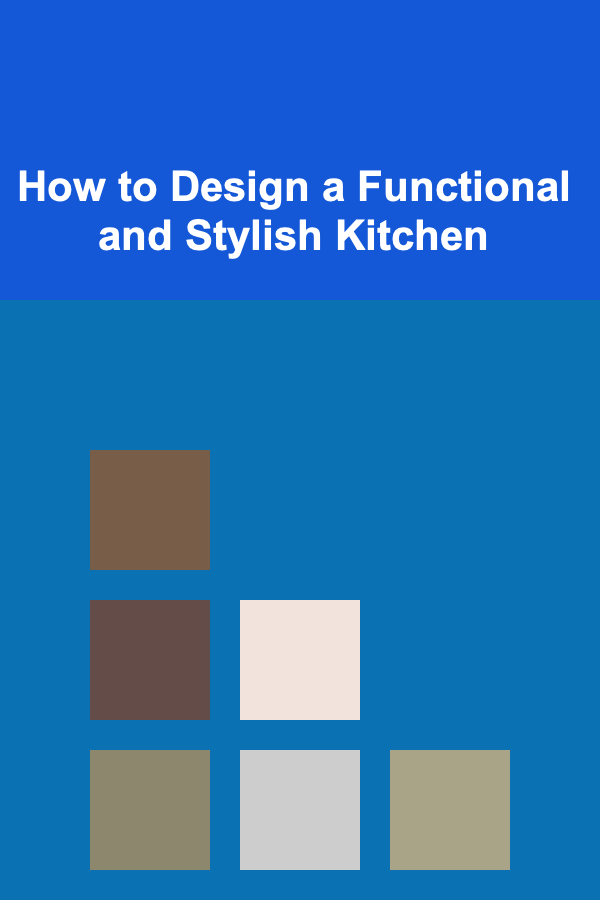
How to Design a Functional and Stylish Kitchen
ebook include PDF & Audio bundle (Micro Guide)
$12.99$11.99
Limited Time Offer! Order within the next:

Designing a kitchen that is both functional and stylish is one of the most rewarding projects a homeowner can undertake. The kitchen is the heart of the home --- a space where meals are prepared, memories are made, and the family gathers. Therefore, it is essential to create a kitchen that is not only aesthetically pleasing but also well-organized and practical. In this article, we will explore how to design a kitchen that balances form and function while meeting the needs of modern life.
Understand the Importance of Functionality
Before diving into the aesthetics of a kitchen design, it is crucial to first consider its functionality. The kitchen is one of the most used spaces in a home, and its design should reflect the needs and habits of those who will use it. A functional kitchen makes cooking, cleaning, and entertaining easier and more efficient, creating a pleasant experience for everyone who steps into the space.
The Kitchen Work Triangle
A fundamental concept in kitchen design is the "work triangle," which refers to the relationship between the three main workstations in the kitchen: the stove, the sink, and the refrigerator. These are the key areas where most kitchen tasks take place, such as cooking, cleaning, and storing ingredients. The work triangle should be designed in a way that minimizes unnecessary movement, allowing the cook to flow smoothly from one station to the next.
- Stove: The stove is the centerpiece of the kitchen and where most cooking takes place. It should be located near the prep area and the sink for convenience.
- Sink: The sink is used for washing dishes, prepping food, and sometimes for hands-on cooking. It should be placed where it is easily accessible from both the stove and the refrigerator.
- Refrigerator: The refrigerator holds the food that will be used during cooking. It should be easily accessible but not directly adjacent to the stove, to avoid clutter.
Counter Space and Storage
Another key element of functionality in kitchen design is counter space. A kitchen needs ample countertop space for food preparation, cooking, and even casual dining or entertaining. Adequate counter space allows for more efficient cooking and helps keep the kitchen organized.
When planning counter space, it's also essential to think about storage. Cabinets, drawers, and pantry space should be optimized to keep everything in its place. Consider vertical storage solutions, such as tall cabinets or open shelving, to maximize space in smaller kitchens. Adjustable shelves and pull-out racks can also make it easier to access your kitchen essentials.
Workflow and Traffic Flow
Consider the layout and traffic flow when designing your kitchen. A functional kitchen layout should allow for easy movement between workstations without obstruction. In a family kitchen, you'll also need to account for the movement of multiple people. For example, a kitchen island can provide a central space for both meal prep and seating, but it should not block the path between key areas, like the sink and refrigerator.
In smaller kitchens, consider an open floor plan or an L-shaped layout to optimize space and allow for smooth traffic flow. In larger kitchens, a U-shaped or galley kitchen layout may be more appropriate, offering even more work surfaces and storage.
Aesthetic Considerations for Style
While functionality is a priority, style is equally important. A kitchen should be a beautiful space that reflects the personality and preferences of the homeowner. Whether you prefer a modern, sleek design or a rustic, farmhouse-inspired kitchen, the aesthetic choices you make will influence the overall feel of the space.
Choose a Theme or Color Palette
The first step in creating a stylish kitchen is to choose a theme or color palette. A well-chosen theme will tie together the design elements and create a cohesive look. Popular kitchen design themes include:
- Modern: Clean lines, minimalist design, and neutral tones such as white, gray, and black.
- Rustic/Farmhouse: Warm wood tones, vintage-inspired accents, and cozy, lived-in vibes.
- Industrial: Exposed brick, steel appliances, and bold lighting.
- Traditional: Classic cabinetry, soft color palettes, and elegant details.
Once you've chosen a theme, pick a color palette that complements it. Neutral tones such as whites, grays, and beiges are versatile and timeless, while bolder hues like navy, emerald, or even mustard can add personality and vibrancy. Make sure the color scheme harmonizes with other elements in your home for a seamless transition between spaces.
Focus on Materials
Materials play a significant role in both the functionality and style of the kitchen. High-quality materials will not only improve the kitchen's durability but also elevate its design.
- Cabinets: Choose materials that are both functional and visually appealing. Wood, whether solid or veneer, adds warmth and texture, while lacquered finishes provide a sleek, modern look. For a more industrial feel, consider metal or matte black finishes.
- Countertops: Quartz, granite, and marble are popular choices for countertops. They are durable, heat-resistant, and provide a luxurious look. For a more budget-friendly option, consider laminate or butcher block counters, which still provide excellent functionality.
- Backsplash: The backsplash serves as both a functional element, protecting the wall from splashes, and a decorative feature. Subway tiles, glass tiles, and mosaic patterns are timeless options, while bold colors or patterns can add a touch of personality.
Lighting
Lighting is a key design element that can transform the atmosphere of your kitchen. In a functional kitchen, lighting needs to be bright and well-distributed. Task lighting is essential above workstations like the stove, sink, and countertops to ensure visibility while preparing meals.
Consider layering lighting to create both functionality and ambiance:
- Ambient Lighting: This is your general, overall lighting, often provided by ceiling-mounted fixtures or recessed lights.
- Task Lighting: Focused lighting above areas like the sink and stove ensures you can work safely and efficiently.
- Accent Lighting: Under-cabinet lights, pendant lights, or a statement chandelier can add a touch of style and highlight your kitchen's design features.
Appliances and Fixtures
Appliances are a major part of the kitchen's functionality, and they should be both efficient and stylish. Today's market offers a wide range of sleek, energy-efficient appliances, from refrigerators and ovens to dishwashers and microwaves.
Stainless steel is a popular choice for kitchen appliances because of its modern, versatile look and durability. However, matte black and custom cabinetry that conceals appliances are also gaining popularity, allowing appliances to blend seamlessly with the kitchen's design.
Additionally, consider high-end fixtures like touchless faucets or smart ovens, which not only add a modern touch but also improve the kitchen's overall efficiency.
Sustainable and Smart Kitchen Design
As sustainability becomes a growing concern for many homeowners, incorporating eco-friendly and energy-efficient features into the kitchen is becoming more common. A sustainable kitchen design not only benefits the environment but also helps save on energy costs in the long term.
Energy-Efficient Appliances
Investing in energy-efficient appliances is one of the best ways to make your kitchen more sustainable. Look for appliances that have Energy Star certification, which means they meet energy efficiency guidelines set by the U.S. Environmental Protection Agency. Refrigerators, dishwashers, ovens, and even water heaters are available in energy-efficient models that reduce electricity consumption and carbon emissions.
Sustainable Materials
When selecting materials for your kitchen, consider choosing those that are eco-friendly and sustainable. Bamboo, for example, is a renewable resource that makes for an attractive and durable kitchen material. Recycled or reclaimed wood is another option that adds character to the space while being environmentally responsible.
Additionally, countertops made from recycled materials or eco-friendly surfaces like recycled glass or concrete are becoming more popular for those looking to reduce their carbon footprint.
Smart Technology Integration
Integrating smart technology into your kitchen can improve both its functionality and sustainability. Smart refrigerators can help you monitor food inventory and reduce waste, while smart lighting systems allow you to control the lighting and energy usage remotely. Smart faucets can conserve water by automatically shutting off after a set time, and smart ovens or cooktops can assist with energy-efficient cooking.
Personalizing Your Kitchen
A kitchen should reflect your personality and taste. Adding personal touches can make the space feel like your own. Here are some ways to infuse personality into your kitchen design:
- Art and Accessories: Display your favorite artwork or photographs on the walls. A few well-chosen accessories, such as a decorative fruit bowl, can add charm and character.
- Open Shelving: Open shelving allows you to showcase beautiful kitchenware, such as vintage plates, colorful bowls, or a collection of cookbooks. It can also add a sense of openness to the space.
- Textiles: The use of textiles, such as decorative towels, runners, and cushions, can add texture and color to your kitchen. Choose fabrics that are both practical and stylish.
Conclusion
Designing a functional and stylish kitchen involves balancing aesthetics with practicality. By considering the kitchen's layout, materials, lighting, and storage solutions, you can create a space that enhances both the beauty and efficiency of your home. With thoughtful design choices and attention to detail, you can transform your kitchen into a space that is not only beautiful but also a joy to cook and entertain in.

How to Build a Checklist for Social Media Event Promotion
Read More
How to Create a Financial Plan After a Major Life Event
Read More
How to Plan a Memorable Party for Special Occasions
Read More
How to Set Up a Mindful Family Meeting
Read More
How to Use Clear Bags for Travel Organization
Read More
How to Use Positive Reinforcement in Pet Training
Read MoreOther Products

How to Build a Checklist for Social Media Event Promotion
Read More
How to Create a Financial Plan After a Major Life Event
Read More
How to Plan a Memorable Party for Special Occasions
Read More
How to Set Up a Mindful Family Meeting
Read More
How to Use Clear Bags for Travel Organization
Read More